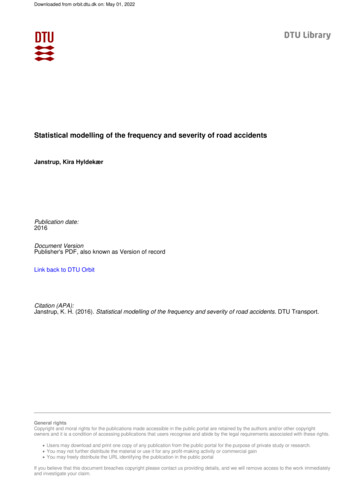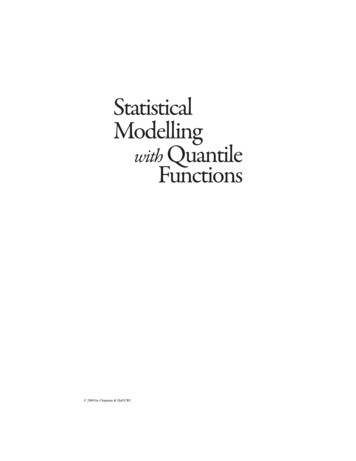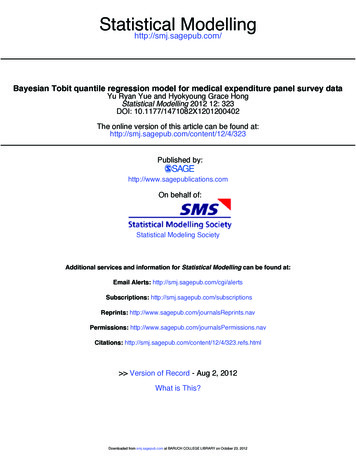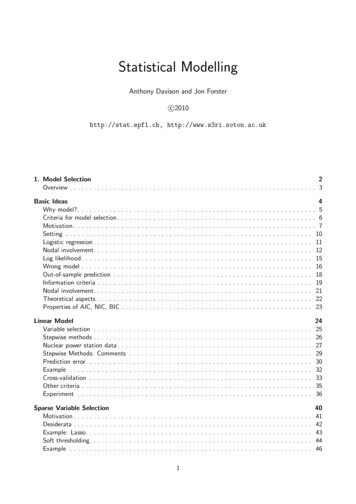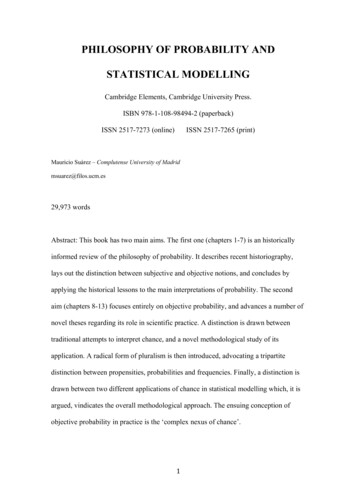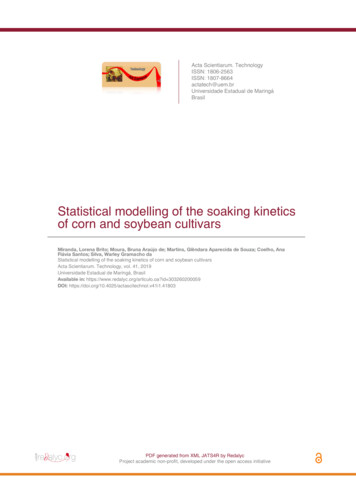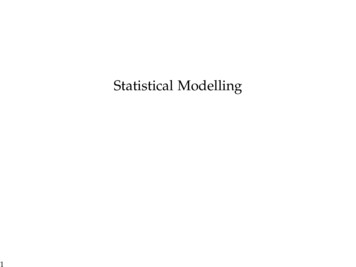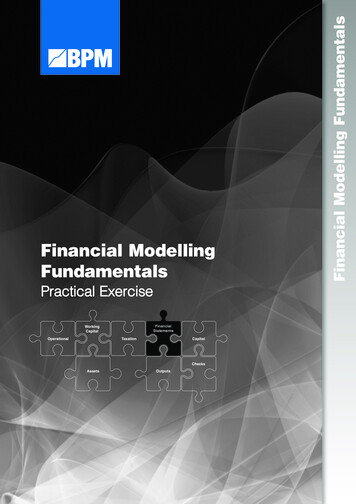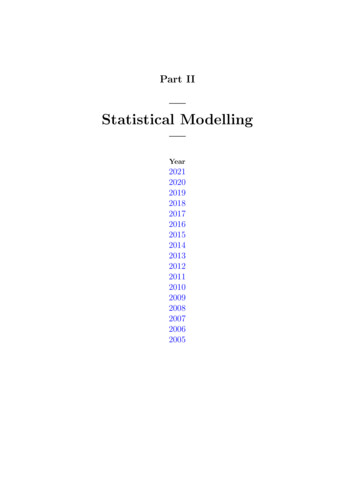
Transcription
Part II—Statistical 1320122011201020092008200720062005
202196Paper 1, Section I5JStatistical ModellingLet µ 0. The probability density function of the inverse Gaussian distribution(with the shape parameter equal to 1) is given by 1(x µ)2f (x; µ) exp .2µ2 x2πx3Show that this is a one-parameter exponential family. What is its natural parameter?Show that this distribution has mean µ and variance µ3 .Paper 2, Section I5JStatistical ModellingDefine a generalised linear model for a sample Y1 , . . . , Yn of independent randomvariables. Define further the concept of the link function. Define the binomial regressionmodel (without the dispersion parameter) with logistic and probit link functions. Whichof these is the canonical link function?Paper 3, Section I5JStatistical ModellingConsider the normal linear model Y X N(Xβ, σ 2 I), where X is a n p designmatrix, Y is a vector of responses, I is the n n identity matrix, and β, σ 2 are unknownparameters.Derive the maximum likelihood estimator of the pair β and σ 2 . What is thedistribution of the estimator of σ 2 ? Use it to construct a (1 α)-level confidence intervalof σ 2 . [You may use without proof the fact that the “hat matrix” H X(X T X) 1 X T isa projection matrix.]Part II, 2021List of Questions
202197Paper 4, Section I5JStatistical ModellingThe data frame data contains the daily number of new avian influenza cases in alarge poultry farm. rbind(head(data, 2), tail(data, 2))Day Count11422613 134214 1442Write down the model being fitted by the R code below. Does the model seem toprovide a satisfactory fit to the data? Justify your answer.The owner of the farm estimated that the size of the epidemic was initially doublingevery 7 days. Is that estimate supported by the analysis below? [You may needlog 2 0.69.] fit - glm(Count Day, family poisson, data) summary(fit)Call:glm(formula Count Day, family poisson, data data)Deviance Residuals:Min1QMedian-1.7298 e Std. Error z value Pr( z )(Intercept)1.56240.17598.883 2e-16 ***Day0.16580.01669.988 2e-16 ***--Signif. codes: 0 ‘***’ 0.001 ‘**’ 0.01 ‘*’ 0.05 ‘.’ 0.1 ‘ ’ 1(Dispersion parameter for poisson family taken to be 1)Null deviance: 122.9660Residual deviance:9.9014on 13on 12degrees of freedomdegrees of freedom pchisq(9.9014, 12, lower.tail FALSE)[1] 0.6246105 plot(Count Day, data) lines(data Day, predict(fit, data, type "response"))[QUESTION CONTINUES ON THE NEXT PAGE]Part II, 2021List of Questions[TURN OVER]
20211020Count3040982468101214DayPart II, 2021List of Questions
202199Paper 1, Section II13J Statistical ModellingThe following data were obtained in a randomised controlled trial for a drug. Dueto a manufacturing error, a subset of trial participants received a low dose (LD) insteadof a standard dose (SD) of the drug. datatreatment1Control2Control3LD4LD5SD6SDoutcome countBetter 5728Worse101Better 1364Worse3Better 4413Worse27(a) Below we analyse the data using Poisson regression: fit1 - glm(count treatment outcome, family poisson, data) fit2 - glm(count treatment * outcome, family poisson, data) anova(fit1, fit2, test "LRT")Analysis of Deviance TableModel 1: count treatment outcomeModel 2: count treatment * outcomeResid. Df Resid. Dev Df Deviance Pr( Chi)1244.48200.00 244.48 2.194e-10 ***--Signif. codes: 0 ‘***’ 0.001 ‘**’ 0.01 ‘*’ 0.05 ‘.’ 0.1 ‘ ’ 1(i) After introducing necessary notation, write down the Poisson models beingfitted above.(ii) Write down the corresponding multinomial models, then state the key theoretical result (the “Poisson trick”) that allows you to fit the multinomialmodels using Poisson regression. [You do not need to prove this theoreticalresult.](iii) Explain why the number of degrees of freedom in the likelihood ratio test is2 in the analysis of deviance table. What can you conclude about the drug?(b) Below is the summary table of the second model:[QUESTION CONTINUES ON THE NEXT PAGE]Part II, 2021List of Questions[TURN OVER]
2021100 summary(fit2)Estimate Std. Error z value(Intercept)8.653120.01321 654.899treatmentLD-1.434940.03013 -47.628treatmentSD-0.260810.02003 -13.021outcomeWorse-4.038000.10038 -40.228treatmentLD:outcomeWorse -2.081560.58664 -3.548treatmentSD:outcomeWorse -1.058470.21758 -4.865--Signif. codes: 0 ‘***’ 0.001 ‘**’ 0.01 ‘*’ 0.05 ‘.’Pr( z ) 2e-16 2e-16 2e-16 2e-160.0003881.15e-06******************0.1 ‘ ’ 1(i) Drug efficacy is defined as one minus the ratio of the probability of worseningin the treated group to the probability of worsening in the control group. Byusing a more sophisticated method, a published analysis estimated that thedrug efficacy is 90.0% for the LD treatment and 62.1% for the SD treatment.Are these numbers similar to what is obtained by Poisson regression? [Hint:e 1 0.37, e 2 0.14, and e 3 0.05, where e is the base of the naturallogarithm.](ii) Explain why the information in the summary table is not enough to test thehypothesis that the LD drug and the SD drug have the same efficacy. Thendescribe how you can test this hypothesis using analysis of deviance in R.Part II, 2021List of Questions
2021101Paper 4, Section II13J Statistical ModellingLet X be an n p non-random design matrix and Y be a n-vector of randomresponses. Suppose Y N(µ, σ 2 I), where µ is an unknown vector and σ 2 0 is known.(a) Let λ 0 be a constant. Consider the ridge regression problemβ̂λ arg min kY Xβk2 λkβk2 .βLet µ̂λ X β̂λ be the fitted values. Show that µ̂λ Hλ Y , whereHλ X(X T X λI) 1 X T .(b) Show that E(kY µ̂λ k2 ) k(I Hλ )µk2 n 2 trace(Hλ ) trace(Hλ2 ) σ 2 .(c) Let Y µ , where N(0, σ 2 I) is independent of Y .kY µ̂λ k2 2σ 2 trace(Hλ ) is an unbiased estimator of E(kY µ̂λ k2 ).Show that(d) Describe the behaviour (monotonicity and limits) of E(kY µ̂λ k2 ) as a functionof λ when p n and X I. What is the minimum value of E(kY µ̂λ k2 )?Part II, 2021List of Questions[TURN OVER]
202088Paper 1, Section I5JStatistical ModellingConsider a generalised linear model with full column rank design matrix X Rn p ,output variables Y (Y1 , . . . , Yn ) Rn , link function g, mean parameters µ (µ1 , . . . , µn )and known dispersion parameters σi2 ai σ 2 , i 1, . . . , n. Denote its variance function byV and recall that g(µi ) xTi β, i 1, . . . , n, where β Rp and xTi is the ith row of X.(a) Define the score function in terms of the log-likelihood function and the Fisherinformation matrix, and define the update of the Fisher scoring algorithm.(b) Let W Rn n be a diagonal matrix with positive entries. Note that X T W X isinvertible. Show that( n)Xargminb RpWii (Yi xTi b)2 (X T W X) 1 X T W Y.i 1 [Hint: you may use that argminb Rp kY X T bk2 (X T X) 1 X T Y.](c) Recall that the score function and the Fisher information matrix have entriesUj (β) ijk (β) nXi 1nXi 1(Yi µi )Xijai σ 2 V (µi )g 0 (µi )aiσ2VXij Xik(µi ){g 0 (µi )}2j 1, . . . , p,j, k 1, . . . , p.Justify, performing the necessary calculations and using part (b), why the Fisher scoringalgorithm is also known as the iterative reweighted least squares algorithm.Part II, 2020List of Questions
202089Paper 2, Section I5JStatistical ModellingThe data frame WCG contains data from a study started in 1960 about heart disease.The study used 3154 adult men, all free of heart disease at the start, and eight and ahalf years later it recorded into variable chd whether they suffered from heart disease (1if the respective man did and 0 otherwise) along with their height and average number ofcigarettes smoked per day. Consider the R code below and its abbreviated output. data.glm - glm(chd height cigs, family binomial, data WCG) summary(data.glm).Coefficients:Estimate Std. Error z value Pr( z )(Intercept) -4.501611.84186 23130.004045.724 1.04e-08.(a) Write down the model fitted by the code above.(b) Interpret the effect on heart disease of a man smoking an average of two packsof cigarettes per day if each pack contains 20 cigarettes.(c) Give an alternative latent logistic-variable representation of the model. [Hint: ifF is the cumulative distribution function of a logistic random variable, its inverse functionis the logit function.]Part II, 2020List of Questions[TURN OVER]
202090Paper 3, Section I5JStatistical ModellingSuppose we have data (Y1 , xT1 ), . . . , (Yn , xTn ), where the Yi are independent conditional on the design matrix X whose rows are the xTi , i 1, . . . , n. Suppose that givenxi , the true probability density function of Yi is fxi , so that the data is generated from anelement of a model F : {(fxi (· ; θ))ni 1 , θ Θ} for some Θ Rq and q N.(a) Define the log-likelihood function for F, the maximum likelihood estimator of θand Akaike’s Information Criterion (AIC) for F.From now on let F be the normal linear model, i.e. Y : (Y1 , . . . , Yn )T Xβ ε,where X Rn p has full column rank and ε Nn (0, σ 2 I).(b) Let σ̂ 2 denote the maximum likelihood estimator of σ 2 . Show that the AIC ofF isn(1 log(2πσ̂ 2 )) 2(p 1).(c) Let χ2n p be a chi-squared distribution on n p degrees of freedom. Using anyresults from the course, show that the distribution of the AIC of F isn log(χ2n p ) n(log(2πσ 2 /n) 1) 2(p 1).[Hint: σ̂ 2 : n 1 kY X β̂k2 n 1 k(I P )εk2 , where β̂ is the maximum likelihoodestimator of β and P is the projection matrix onto the column space of X.]Part II, 2020List of Questions
202091Paper 4, Section I5JStatistical ModellingSuppose you have a data frame with variables response, covar1, and covar2. Yourun the following commands on R.model - lm(response covar1 covar2)summary(model).Estimate Std. Error t value Pr( t )(Intercept) -2.10240.1157 -18.164 80.1450.886.(a) Consider the following three scenarios:(i) All the output you have is the abbreviated output of summary(model) above.(ii) You have the abbreviated output of summary(model) above together withResidual standard error: 0.8097 on 47 degrees of freedomMultiple R-squared: 0.8126, Adjusted R-squared: 0.8046F-statistic: 101.9 on 2 and 47 DF, p-value: 2.2e-16(iii) You have the abbreviated output of summary(model) above together withResidual standard error: 0.9184 on 47 degrees of freedomMultiple R-squared: 0.000712, Adjusted R-squared: -0.04181F-statistic: 0.01674 on 2 and 47 DF, p-value: 0.9834What conclusion can you draw about which variables explain the response in eachof the three scenarios? Explain.(b) Assume now that you have the abbreviated output of summary(model) abovetogether withanova(lm(response 1), lm(response covar1), model).Res.DfRSS Df Sum of SqF Pr( F)149 164.4482? 30.831 ?133.618? 2e-163? 30.817 ?0.014?.What are the values of the entries with a question mark? [You may express your answersas arithmetic expressions if necessary].Part II, 2020List of Questions[TURN OVER]
202092Paper 1, Section II13J Statistical ModellingWe consider a subset of the data on car insurance claims from Hallin and Ingenbleek(1983). For each customer, the dataset includes total payments made per policy-year, theamount of kilometres driven, the bonus from not having made previous claims, and thebrand of the car. The amount of kilometres driven is a factor taking values 1, 2, 3, 4, or 5,where a car in level i 1 has driven a larger number of kilometres than a car in level i forany i 1, 2, 3, 4. A statistician from an insurance company fits the following model on R. model1 - lm(Paymentperpolicyyr as.numeric(Kilometres) Brand Bonus)(i) Why do you think the statistician transformed variable Kilometres from a factorto a numerical variable?(ii) To check the quality of the model, the statistician applies a function to model1which returns the following figure: 900 1100 1300log Likelihood95% 2 1012λWhat does the plot represent? Does it suggest that model1 is a good model?Explain. If not, write down a model which the plot suggests could be better.[QUESTION CONTINUES ON THE NEXT PAGE]Part II, 2020List of Questions
202093(iii) The statistician fits the model suggested by the graph and calls it model2.Consider the following abbreviated output: summary(model2).Coefficients:Estimate Std. Error t value Pr( t )(Intercept)6.5140350.186339 34.958 2e-16as.numeric(Kilometres) 0.0571320.0326541.750 0.08126Brand20.3638690.1868571.947 0.05248.Brand90.1254460.1868570.671 0.50254Bonus-0.1780610.022540 -7.900 6.17e-14--Signif. codes: 0 ‘***’ 0.001 ‘**’ 0.01 ‘*’ 0.05 ‘.’ 0.1 ‘ ’Residual standard error: 0.7817 on 284 degrees of freedom.***.***1Using the output, write down a 95% prediction interval for the ratio between thetotal payments per policy year for two cars of the same brand and with the same value ofBonus, one of which has a Kilometres value one higher than the other. You may expressyour answer as a function of quantiles of a common distribution, which you should specify.(iv) Write down a generalised linear model for Paymentperpolicyyr which may bea better model than model1 and give two reasons. You must specify the link function.Part II, 2020List of Questions[TURN OVER]
202094Paper 4, Section II13J Statistical Modelling(a) Define a generalised linear model (GLM) with design matrix X Rn p ,output variables Y : (Y1 , . . . , Yn )T and parameters µ : (µ1 , . . . , µn )T , β Rp andσi2 : ai σ 2 (0, ), i 1, . . . , n. Derive the moment generating function of Y , i.e. giveTan expression for E exp t Y , t Rn , wherever it is well-defined.Assume from now on that the GLM satisfies the usual regularity assumptions, Xhas full column rank, and σ 2 is known and satisfies 1/σ 2 N. Tbe the output variables of a GLM from the same(b) Let Ỹ : Ỹ1 , . . . , Ỹn/σ22family as that of part (a) and parameters µ̃ : (µ̃1 , . . . , µ̃n/σ2 )T and σ̃ 2 : (σ̃12 , . . . , σ̃n/σ2 ).2Suppose the output variables may be split into n blocks of size 1/σ with constantparameters. To be precise, for each block i 1, . . . , n, if j {(i 1)/σ 2 1, . . . , i/σ 2 }thenµ̃j µiandσ̃j2 aiwith µi µi (β) and ai defined as in part (a). Let Ȳ : (Ȳ1 , . . . , Ȳn )T , where Ȳi : P1/σ2σ 2 k 1 Ỹ(i 1)/σ2 k .(i) Show that Ȳ is equal to Y in distribution. [Hint: you may use without proof thatmoment generating functions uniquely determine distributions from exponential dispersionfamilies.]P1/σ22(ii) For any ỹ Rn/σ , let ȳ (ȳ1 , . . . , ȳn )T , where ȳi : σ 2 k 1 ỹ(i 1)/σ2 k . Showthat the model function of Ỹ satisfies f ỹ; µ̃, σ̃ 2 g1 ȳ; µ̃, σ̃ 2 g2 ỹ; σ̃ 2for some functions g1 , g2 , and conclude that Ȳ is a sufficient statistic for β from Ỹ .(iii) For the model and data from part (a), let µ̂ be the maximum likelihoodestimator for µ and let D(Y ; µ) be the deviance at µ. Using (i) and (ii), show that()02supµ̃0 Mf1 f (Ỹ ; µ̃ , σ̃ )D(Y ; µ̂) d 2 log,02σ2supµ̃0 Mf0 f (Ỹ ; µ̃ , σ̃ )f0 and Mf1 are nested subspaces of Rn/σ2where d means equality in distribution and Mf1 ) n and dim(Mf0 ) p, and, assumingwhich you should specify. Argue that dim(Mthe usual regularity assumptions, conclude thatD(Y ; µ̂) d 2 χn pσ2as σ 2 0,stating the name of the result from class that you use.Part II, 2020List of Questions
201998Paper 4, Section I5JStatistical ModellingIn a normal linear model with design matrix X Rn p , output variables y Rnand parameters β Rp and σ 2 0, define a (1 α)-level prediction interval for a newobservation with input variables x Rp . Derive an explicit formula for the interval,proving that it satisfies the properties required by the definition.σ 2 ky[You may assume that the maximum likelihood estimator β̂ is independent of X β̂k22 , which has a χ2n p distribution.]Paper 3, Section I5JStatistical Modelling(a) For a given model with likelihood L(β), β Rp , define the Fisher informationmatrix in terms of the Hessian of the log-likelihood.Consider a generalised linear model with design matrix X Rn p , output variablesy Rn , a bijective link function, mean parameters µ (µ1 , . . . , µn ) and dispersionparameters σ12 · · · σn2 σ 2 0. Assume σ 2 is known.(b) State the form of the log-likelihood.(c) For the canonical link, show that the Fisher information matrix is equal toσ 2 X T W X,for a diagonal matrix W depending on the means µ. Compute the entries of W in termsof µ.Part II, 2019List of Questions
201999Paper 2, Section IPart II, 2019List of Questions[TURN OVER
20191005JStatistical ModellingThe cycling data frame contains the results of a study on the effects of cycling towork among 1,000 participants with asthma, a respiratory illness. Half of the participants,chosen uniformly at random, received a monetary incentive to cycle to work, and the otherhalf did not. The variables in the data frame are: miles: the average number of miles cycled per week episodes: the number of asthma episodes experienced during the study incentive: whether or not a monetary incentive to cycle was given history: the number of asthma episodes in the year preceding the studyConsider the R code below and its abbreviated output. lm.1 lm(episodes miles history, data cycling) summary(lm.1)Coefficients:Estimate Std. Error t value Pr( t )(Intercept) 0.669370.079658.404 2e-16 ***miles-0.049170.01839 -2.674 0.00761 **history1.489540.04818 30.918 2e-16 *** lm.2 lm(episodes incentive history, data cycling) summary(lm.2)Coefficients:Estimate Std. Error t value Pr( t )(Intercept)0.095390.069601.3710.171incentiveYes 0.913870.06504 14.051 2e-16 ***history1.468060.04346 33.782 2e-16 *** lm.3 lm(miles incentive history, data cycling) summary(lm.3)Coefficients:Estimate Std. Error t value Pr( t )(Intercept)1.470500.11682 12.588 2e-16 ***incentiveYes 1.732820.10917 15.872 2e-16 ***history0.473220.072946.487 1.37e-10 ***(a) For each of the fitted models, briefly explain what can be inferred aboutparticipants with similar histories.(b) Based on this analysis and the experimental design, is it advisable for aparticipant with asthma to cycle to work more often? Explain.Part II, 2019List of Questions
2019101Paper 1, Section I5JStatistical ModellingThe Gamma distribution with shape parameter α 0 and scale parameter λ 0has probability density functionf (y; α, λ) λα α 1 λyyeΓ(α)for y 0where Γ is the Gamma function. Give the definition of an exponential dispersion familyand show that the set of Gamma distributions forms one such family. Find the cumulantgenerating function and derive the mean and variance of the Gamma distribution as afunction of α and λ.Part II, 2019List of Questions[TURN OVER
2019102Paper 4, Section II13J Statistical ModellingA sociologist collects a dataset on friendships among m Cambridge graduates. Letyi,j 1 if persons i and j are friends 3 years after graduation, and yi,j 0 otherwise.[You may assume that yi,j yj,i and yi,i 0.] Let zi be a categorical variable for personi’s college, taking values in the set {1, 2, . . . , C}. Consider logistic regression models,P(yi,j 1) eθi,j,1 eθi,j1 6 i j 6 m,with parameters either(i) θi,j βzi ,zj ; or,(ii) θi,j βzi βzj ; or,(iii) θi,j βzi βzj β0 δzi ,zj , where δzi ,zj 1 if zi zj and 0 otherwise.(a) Write down the likelihood of the models.(b) Show that the three models are nested and specify the order. Suggest a statisticto compare models (i) and (iii), give its definition and specify its asymptotic distributionunder the null hypothesis, citing any necessary theorems.(c) Suppose persons i and j are in the same college k; consider the number offriendships, Mi and Mj , that each of them has with people in college ℓ 6 k (ℓ andk fixed). In each of the models above, compare the distribution of these two randomvariables. Explain why this might lead to a poor quality of fit.(d) Find a minimal sufficient statistic for β (βk )k 0,1,.,C in model (iii). [Youmay use the following characterisation of a minimal sufficient statistic: let f (β; y) be thelikelihood in this model, where y (yi,j )i,j 1,.,m ; suppose T t(y) is a statistic such thatf (β; y)/f (β; y ′ ) is constant in β if and only if t(y) t(y ′ ); then, T is a minimal sufficientstatistic for β.]Part II, 2019List of Questions
2019103Paper 1, Section IIPart II, 2019List of Questions[TURN OVER
201910413JStatistical ModellingThe ice cream data frame contains the result of a blind tasting of 90 ice creams,each of which is rated as poor, good, or excellent. It also contains the price of each icecream classified into three categories. Consider the R code below and its output. table(ice cream)scorepriceexcellent good poorhigh12810low7914medium12117 ice cream.counts as.data.frame(xtabs(Freq price score, data table(ice cream))) glm.fit glm(Freq price score,data ice cream.counts,family "poisson") summary(glm.fit)Call:glm(formula Freq price score - 1, family "poisson", data ice cream.counts)Deviance Residuals:1234567890.5054 -1.10190.5054 -0.4475 -0.10980.5304 -0.10431.0816 -1.1019Coefficients:Estimate Std. Error z value Pr( z )pricehigh2.335e 00 2.334e-0110.01 2e-16 ***pricelow2.335e 00 2.334e-0110.01 2e-16 ***pricemedium 2.335e 00 2.334e-0110.01 2e-16 ***scoregood-1.018e-01 2.607e-01-0.390.696scorepoor3.892e-14 2.540e-010.001.000--Signif. codes: 0 ’***’ 0.001 ’**’ 0.01 ’*’ 0.05 ’.’ 0.1 ’ ’ 1(Dispersion parameter for poisson family taken to be 1)Null deviance: 257.2811Residual deviance:4.6135AIC: 51.791on 9on 4degrees of freedomdegrees of freedom(a) Write down the generalised linear model fitted by the code above.(b) Prove that the fitted values resulting from the maximum likelihood estimator ofthe coefficients in this model are identical to those resulting from the maximum likelihoodestimator when fitting a multinomial model which assumes the number of ice creams ateach price level is fixed.(c) Using the output above, perform a goodness-of-fit test at the 1% level, specifyingthe null hypothesis, the test statistic, its asymptotic null distribution, any assumptions ofthe test and the decision from your test.(d) If we believe that better ice creams are more expensive, what could be a morepowerful test against the model fitted above and why?Part II, 2019List of Questions
201898Paper 4, Section IPart II, 2018List of Questions
2018995JStatistical ModellingA scientist is studying the effects of a drug on the weight of mice. Forty mice aredivided into two groups, control and treatment. The mice in the treatment group aregiven the drug, and those in the control group are given water instead. The mice are keptin 8 different cages. The weight of each mouse is monitored for 10 days, and the resultsof the experiment are recorded in the data frame Weight.data. Consider the following Rcode and its output. head(Weight.data)TimeGroup Cage MouseWeight11 Control11 24.7757822 Control11 24.6876633 Control11 24.7900844 Control11 24.7700555 Control11 24.6509266 Control11 24.38436 mod1 lm(Weight Time*Group Cage, data Weight.data) summary(mod1)Call:lm(formula Weight Time * Group Cage, data Weight.data)Residuals:Min1QMedian-1.36903 -0.33527 -0.017193Q0.38807Max1.24368Coefficients:Estimate Std. Error t value Pr( t )(Intercept)24.5347710.100336 244.525 2e-16 ***Time-0.0060230.012616 -0.477 0.63334GroupTreatment0.3218370.1219932.638 0.00867 **Cage2-0.4002280.095875 -4.174 3.68e-05 ***Cage30.2869410.1024942.800 0.00537 **Cage40.0075350.0958750.079 0.93740Cage60.1247670.1255300.994 0.32087Cage8-0.2951680.125530 -2.351 0.01920 *Time:GroupTreatment -0.1735150.017842 -9.725 2e-16 ***--Signif. codes: 0 ‘***’ 0.001 ‘**’ 0.01 ‘*’ 0.05 ‘.’ 0.1 ‘ ’ 1Residual standard error: 0.5125 on 391 degrees of freedomMultiple R-squared: 0.5591,Adjusted R-squared:0.55F-statistic: 61.97 on 8 and 391 DF, p-value: 2.2e-16Which parameters describe the rate of weight loss with time in each group?According to the R output, is there a statistically significant weight loss with time inPart II, 2018List of Questions[TURN OVER
2018100the control group?Three diagnostic plots were generated using the following R code.0.20.10.0 0.1mod1 residuals[mouse1]mouse1 (Weight.data Mouse 1)plot(Weight.data Time[mouse1],mod1 residuals[mouse1])mouse2 (Weight.data Mouse 2)plot(Weight.data Time[mouse2],mod1 residuals[mouse2])mouse3 (Weight.data Mouse 3)plot(Weight.data Time[mouse3],mod1 residuals[mouse3])2468100.30.1 0.1mod1 residuals[mouse2]0.5Weight.data Time[mouse1]246810Weight.data Time[mouse2]Part II, 2018List of Questions
2018 0.5 0.6 0.7 0.8mod1 residuals[mouse3]101246810Weight.data Time[mouse3]Based on these plots, should you trust the significance tests shown in the output ofthe command summary(mod1)? Explain.Part II, 2018List of Questions[TURN OVER
2018102Paper 3, Section I5JStatistical ModellingThe data frame Cases.of.flu contains a list of cases of flu recorded in 3 Londonhospitals during each month of 2017. Consider the following R code and its output. table(Cases.of.flu)HospitalMonthABCApril10 40 27August9 34 19December24 129 81February49 134 74January45 138 78July5 47 35June11 36 22March20 82 41May5 43 23November17 82 62October6 26 19September6 40 21 Cases.of.flu.table as.data.frame(table(Cases.of.flu)) head(Cases.of.flu.table)Month Hospital Freq1AprilA102AugustA93 DecemberA244 FebruaryA495 JanuaryA456JulyA5 mod1 glm(Freq ., data Cases.of.flu.table, family poisson) mod1 dev[1] 28.51836 levels(Cases.of.flu Month)[1] "April""August""December" "February" "January""July"[7] "June""March""May""November" "October""September" levels(Cases.of.flu Month) - c("Q2","Q3","Q4","Q1","Q1","Q3", "Q2","Q1","Q2","Q4","Q4","Q3") Cases.of.flu.table as.data.frame(table(Cases.of.flu)) mod2 glm(Freq ., data Cases.of.flu.table, family poisson) mod2 dev[1] 17.9181Describe a test for the null hypothesis of independence between the variables Monthand Hospital using the deviance statistic. State the assumptions of the test.Perform the test at the 1% level for each of the two different models shown above.You may use the table below showing 99th percentiles of the χ2p distribution with a range ofdegrees of freedom p. How would you explain the discrepancy between their conclusions?Part II, 2018List of Questions
2018103Degrees of freedom123456789101112131415161718192099th .1937.57Degrees of h 62.4363.69Paper 2, Section I5JStatistical ModellingConsider a linear model Y Xβ σ 2 ε with ε N (0, I), where the design matrixX is n by p. Provide an expression for the F -statistic used to test the hypothesisβp0 1 βp0 2 · · · βp 0 for p0 p. Show that it is a monotone function of alog-likelihood ratio statistic.Part II, 2018List of Questions[TURN OVER
2018104Paper 1, Section I5JStatistical ModellingThe data frame Ambulance contains data on the number of ambulance requestsfrom a Cambridgeshire hospital on different days. In addition to the number of ambulancerequests on each day, the dataset records whether each day fell in the winter season, on aweekend, or on a bank holiday, as well as the pollution level on each day. head(Ambulance)Winter Weekend Bank.holiday Pollution.level um25A health researcher fitted two models to the dataset above using R. Consider thefollowing code and its output. mod1 glm(Ambulance.requests ., data Ambulance, family poisson) summary(mod1)Call:glm(formula Ambulance.requests ., family poisson, data Ambulance)Deviance Residuals:Min1QMedian-3.2351 -0.8157 -0.09823Q0.7787Max3.6568Coefficients:Estimate Std. Error z value Pr( z )(Intercept)2.9684770.036770 80.732 2e-16 ***WinterYes0.5477560.033137 16.530 2e-16 ***WeekendYes-0.6079100.038184 -15.921 2e-16 ***Bank.holidayYes0.1656840.0498753.322 0.000894 ***Pollution.levelLow-0.0327390.042290 -0.774 0.438846Pollution.levelMedium -0.0015870.040491 -0.039 0.968734--Signif. codes: 0 ‘***’ 0.001 ‘**’ 0.01 ‘*’ 0.05 ‘.’ 0.1 ‘ ’ 1(Dispersion parameter for poisson family taken to be 1)Null deviance: 818.08Residual deviance: 304.97AIC: 1262.4on 199on 194degrees of freedomdegrees of freedomPart II, 2018List of Questions
2018105 mod2 glm(Ambulance.requests Winter Weekend, data Ambulance, family poisson) summary(mod2)Call:glm(formula Ambulance.requests Winter Weekend, family poisson,data Ambulance)Deviance Residuals:Min1QMedian-3.4480 -0.8544 -0.11533Q0.7689Max3.5903Coefficients:Estimate Std. Error z value Pr( z )(Intercept) 2.970770.02163 137.34 2e-16 ***WinterYes0.555860.0326817.01 2e-16 ***WeekendYes -0.603710.03813 -15.84 2e-16 ***--Signif. codes: 0 ‘***’ 0.001 ‘**’ 0.01 ‘*’ 0.05 ‘.’ 0.1 ‘ ’ 1(Dispersion parameter for poisson family taken to be 1)Null deviance: 818.08Residual deviance: 316.39AIC: 1267.9on 199on 197degrees of freedomdegrees of freedomDefine the two models fitted by this code and perform a hypothesis test with level1% in which one of the models is the null hypothesis and the other is the alternative. Statethe theorem used in this hypothesis test. You may use the information generated by thefollowing commands. qchisq(0.01,[1] 9.21034 qchisq(0.01,[1] 11.34487 qchisq(0.01,[1] 13.2767 qchisq(0.01,[1] 15.08627df 2, lower.tail FALSE)Part II, 2018List of Questionsdf 3, lower.tail FALSE)df 4, lower.tail FALSE)df 5, lower.tail FALSE)[TURN OVER
2018106Paper 4, Section II13J Statistical ModellingBridge is a card game played by 2 teams of 2 players each. A bridge club recordsthe outcomes of many ga
5J Statistical Modelling Let 0. The probability density function of the inverse Gaussian distribution (with the shape parameter equal to 1) is given by f (x ; ) 1 p 2 x 3 exp (x )2 2 2 x : Show that this is a one-parameter exponential family. What is its natural parameter? Show that this

